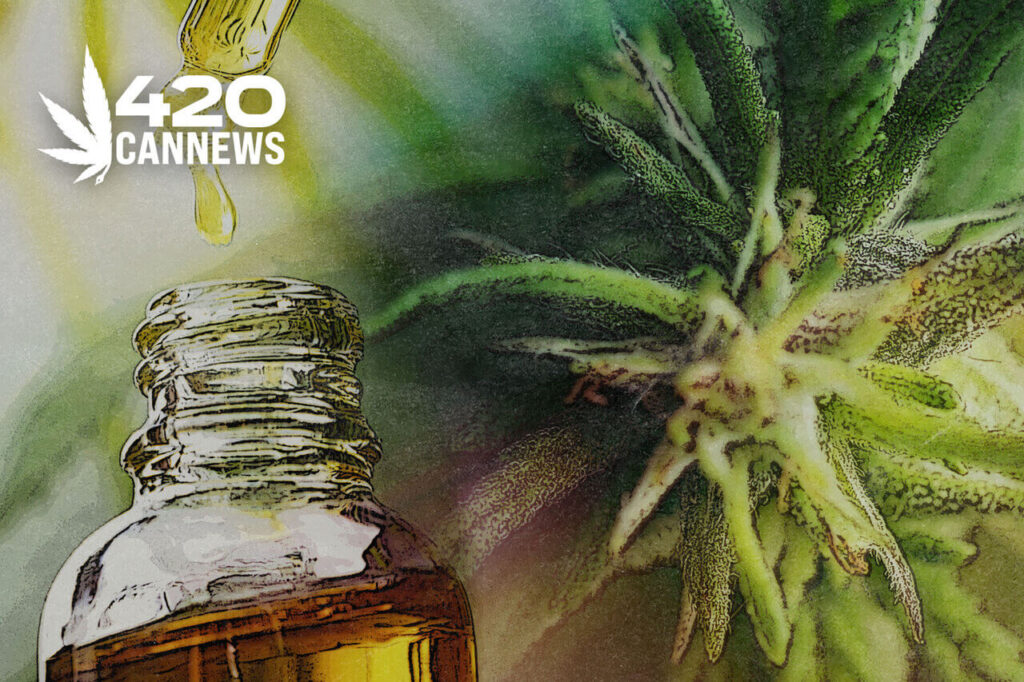Part of an ongoing service to present the most comprehensive and up-to-date information on the ever-evolving world of cannabis, 420CanNews will delve into the topic of CBDA vs. CBD. These two compounds represent the cutting edge of cannabis science and are continually reshaping our understanding of its wellness benefits. Understanding the differences between these substances is key to appreciating the full potential of hemp products and making informed choices about their uses.
Key Takeaways
| Key Points | CBDA | CBD |
| Chemical Form | Acidic precursor to CBD | Decarboxylated form of CBDA |
| Benefits | Potential for inflammation, nausea, and anxiety | Known for pain relief, anxiety reduction, and sleep enhancement |
| Psychoactivity | Non-psychoactive | Non-psychoactive |
| Legality | Depends on jurisdiction | Widely legal in various forms |
| Research Status | Emerging research | Extensive research and clinical trials |
| Common Formats | Raw cannabis, juices, tinctures | Oils, edibles, creams, vapes |
Glossary
- Cannabinoids: Chemical compounds found in the cannabis plant that interact with receptors in the brain and body to produce various effects.
- CBD (Cannabidiol): A non-psychoactive cannabinoid known for its potential therapeutic effects, including relief from pain, anxiety, and inflammation.
- CBDA (Cannabidiolic Acid): The acidic, raw form of CBD that exists in the cannabis plant before it is decarboxylated into CBD.
- Decarboxylation: A chemical reaction that removes a carboxyl group from a molecule, converting CBDA into CBD. This typically occurs through the application of heat.
- Pharmacokinetics: The branch of pharmacology concerned with the movement of drugs within the body, including the processes of absorption, distribution, metabolism, and excretion.
- Bioavailability: The proportion of a drug or other substance that has an active effect on the body when it enters the circulation.
What is CBDA?
Cannabidiolic Acid, or CBDA, is a cannabinoid found in the raw cannabis plant. It’s considered the acidic precursor of CBD, existing in the plant before it undergoes the drying or heating process known as decarboxylation. When cannabis is heated, CBDA converts into CBD, a transformation that increases its potential for interaction with the body’s systems.
The Chemistry of CBDA
CBDA is structurally similar to CBD but has an additional carboxyl group (-COOH) attached to its molecular chain. This carboxyl group is what makes it an “acidic” cannabinoid. The process of decarboxylation, typically through drying or heating, removes this group, converting CBDA into CBD. This transformation is significant as it alters the compound’s pharmacology, potentially enhancing its affinity and efficacy in interacting with the body’s endocannabinoid receptors.
CBDA Case Studies
While comprehensive clinical trials are limited, several anecdotal reports and smaller case studies have highlighted CBDA’s effectiveness in various conditions. For instance, one case study from 2021 showed that individuals undergoing anticancer treatment experienced greater relief from nausea and vomiting while using CBDA products compared to conventional CBD products. Such case studies, while not as conclusive as large-scale research, provide a basis for understanding CBDA’s potential and pave the way for future scientific exploration.
CBDA and Alzheimer’s Disease
Alzheimer’s Disease (AD) stands as one of the most challenging neurodegenerative disorders, characterized by progressive memory loss and cognitive decline. Recent scientific endeavors have begun exploring the potential of cannabinoids, like CBDA, as a potential treatment method. A study from April 2023 has illuminated the promising role of CBDA in combating Alzheimer’s Disease-like symptoms and pathology. Although this initial study was performed on rats, it marks a significant stride in understanding this compound’s neuroprotective capabilities.
Research Findings
- Neuronal Protection: CBDA reduced cell death by 75% in cortical neurons treated with the protein amyloid-beta, one of the key markers for the diagnosis of Alzheimer’s.
- Reduced Levels of Amyloid-beta and Tau: The treatment with CBDA led to a reduction in amyloid-beta and phosphorylated tau, both of which are key protein markers in Alzheimer’s disease progression.
- Decreased Calcium Buildup: CBDA was also found to reduce unhealthy concentrations of calcium in neurons—something commonly found in demented patients—by up to 51%.
- Cognitive Function Improvement: In animal models, CBDA improved cognitive functions, showing enhanced learning and memory capabilities.
Protecting Brain Cells
The study revealed that CBDA might act as a shield for the brain’s nerve cells. In Alzheimer’s, harmful proteins accumulate and lead to the death of these cells, contributing to memory loss and cognitive decline. The results showed that CBDA helped reduce this cell death by 75% of the increased levels measured. Essentially, it’s like having a protective barrier that helps keep the brain’s cells alive and healthy for longer, even in the presence of these detrimental proteins.
Tackling Harmful Protein Buildup
Alzheimer’s progression is often marked by the buildup of amyloid-beta and tau proteins, leading to the formation of plaques and tangles in the brain. These not only disrupt brain function but are also key markers of the disease’s progression. CBDA has been observed to decrease the levels of these proteins, suggesting it might help slow or alter the course of Alzheimer’s.
Managing Calcium Levels
In the study, CBDA demonstrated a potential to rebalance the elevated calcium levels often found in brain cells affected by Alzheimer’s. Typically, calcium is crucial for cellular communication, but in Alzheimer’s, the presence of harmful proteins like amyloid-beta and tau disrupts this balance, leading to cell damage and disease progression. CBDA reduced this calcium overload by as much as 51%, suggesting it might help restore a healthier equilibrium within the brain cells. This indicates CBDA’s potential as a dual-action agent in Alzheimer’s treatment, offering not only protection against cell death but also a recalibration of critical cellular processes.
Enhancing Brain Function
The cognitive decline in Alzheimer’s is devastating, affecting the ability to think, remember, and live independently. The study also pointed out that CBDA might bolster cognitive functions, as evidenced in animal models showing improved learning and memory capabilities. This means that CBDA could potentially help maintain or even improve cognitive functions, providing a better quality of life for individuals facing Alzheimer’s.
Research Conclusions
These findings suggest that CBDA has potential neuroprotective and cognitive benefits, making it a compound of interest for further research in neurodegenerative diseases like Alzheimer’s. While these results are promising, it is important to note that more research, including human clinical trials, is necessary to fully understand and validate the therapeutic potential of CBDA.
What is CBD?
Cannabidiol, or CBD, is perhaps the most well-known cannabinoid next to THC. Unlike THC, CBD is non-psychoactive, meaning it doesn’t produce the high traditionally associated with cannabis use. Its wide array of potential therapeutic benefits has made it a popular subject of research and consumer interest.
Is CBD Legal?
In the United States, CBD derived from hemp (cannabis containing 0.3% THC or less) is legal, while CBD derived from marijuana (which contains more than 0.3% THC by dry weight) is subject to stricter regulations due to its higher THC content. Always check local and federal laws regarding CBD and CBDA as regulations continue to evolve.
CBD Products and Uses
CBD is available in various forms, including oils, edibles, creams, and vapes. Each kind offers different benefits:
- Oils: Typically taken sublingually for quick absorption.
- Edibles: Offer a discreet and easy way to consume CBD with a delayed onset.
- Creams: Applied topically, beneficial for localized issues like pain or skin conditions.
- Vapes: Provide the fastest method of delivery but come with potential respiratory risks.
When choosing a product, consider the quality, source, and concentration of CBD. Look for products tested by third-party labs and made from high-quality, organic hemp.
Side Effects of CBD
CBD is generally well-tolerated, but some individuals may experience side effects, especially at higher doses. Common side effects include dry mouth, dizziness, and changes in appetite or mood. It’s also important to consider potential interactions with other medications. Always start with a low dose and consult with a healthcare provider, particularly if you have underlying health conditions or are taking other medications.
CBDA and CBD Research
The future of CBD and CBDA in therapeutic applications looks promising. Ongoing research continues to uncover new potential benefits and applications for these compounds. As the legal landscape evolves and more studies emerge, we can expect to see an expansion in the use of CBD and CBDA in various health and wellness products.
CBDA vs. CBD: Differences and Effects
What Is the Difference Between CBDA and CBD?
Determining whether CBDA is better than CBD isn’t straightforward. Research on CBDA is still emerging, but it has shown promising results, particularly as a more potent inhibitor of the COX-2 enzyme, which is linked to reducing discomfort. CBDA’s potency could also make it more effective than CBD in alleviating symptoms like stomach discomfort and nervousness. However, it’s important to note that CBDA can transform into CBD even at room temperature through decarboxylation, potentially affecting its efficacy.
On the other hand, anecdotal evidence strongly supports CBD’s ability to enhance mood and alleviate physical discomfort, and over 200 clinical trials studying its effects are currently underway. In terms of availability, CBD is more widely accessible, making it a more convenient option for many. Each compound has its unique attributes and potential benefits, and understanding how each of these compounds interacts with the body is crucial to comprehending their therapeutic potential.
How do CBD and CBDA Interact with the Body?
The endocannabinoid system (ECS) plays a crucial role in maintaining bodily homeostasis and is involved in regulating various physiological processes, including pain sensation, mood, appetite, and memory. Both CBD and CBDA interact with the ECS, but they do so in different ways. CBD has been shown to have a direct interaction with the ECS, influencing receptors such as the CB1 and CB2 receptors, as well as other parts of the body. On the other hand, CBDA does not bind directly with CB1 or CB2 receptors but is believed to interact with the ECS by inhibiting certain enzymes and enhancing the levels of endocannabinoids.
Potential Benefits:
- CBDA: CBDA has shown promise in reducing cell death and the levels of amyloid-beta and phosphorylated tau in the context of Alzheimer’s Disease-like conditions. These neuroprotective and anti-inflammatory properties make it a subject of interest for further research in neurodegenerative diseases and other conditions characterized by inflammation and oxidative stress.
- CBD: CBD is known for its wide range of therapeutic effects, including its anti-inflammatory, analgesic, anxiolytic, antipsychotic, and anticonvulsant properties. Its ability to interact with a wide range of receptors and pathways in the body makes it a versatile compound for treating a variety of conditions.
How to Choose between CBDA and CBD
When deciding between CBDA and CBD, several factors should be considered, including the specific health condition being targeted, the desired effects, and the individual’s unique physiological makeup. Here are some considerations:
Individual Needs and Desired Effects
- For those seeking anti-inflammatory or neuroprotective effects: Based on recent research findings, CBDA might be a more suitable choice due to its potent effects in these areas.
- For those looking for established effects: CBD might be the preferred option due to the extensive research supporting its benefits.
What Types of CBDA and CBD Products Are Available?
- CBDA: CBDA is most commonly found in raw cannabis, fresh juices, and tinctures made from high-CBDA strains. As it is sensitive to heat, it is important to use methods that preserve its acidic form.
- CBD: CBD is available in a wide range of products, including oils, edibles, creams, and vapes, each offering different benefits and experiences.
Can You Use CBDA and CBD Together?
In the ever-evolving world of cannabis therapeutics, one question that often surfaces is whether combining different cannabinoids can enhance their individual benefits. Specifically, many are curious about the potential of using CBDA and CBD together. This section explores the feasibility, potential benefits, and considerations of using CBDA and CBD in tandem, offering insights into how these two cannabinoids might complement each other.
How Does CBDA Interact with CBD?
The interaction between CBDA and CBD is rooted in the concept known as the “entourage effect,” which posits that cannabinoids can work synergistically, enhancing each other’s effects. While CBDA is the acidic precursor to CBD, the two compounds interact with the body’s systems in slightly different ways. When used together, they may offer a more comprehensive approach to health and wellness, potentially amplifying the benefits beyond what each could achieve alone.
Potential Benefits of CBDA and CBD
- Enhanced Effects: The combination of CBDA and CBD might result in enhanced efficacy in treating certain conditions, providing a more potent therapeutic effect than using either cannabinoid alone.
- Broader Therapeutic Relief: Together, CBDA and CBD might address a wider array of symptoms or conditions, leveraging their individual properties to offer a broader spectrum of relief.
- Improved Absorption Rates: Some evidence suggests that certain cannabinoids can affect the absorption and metabolism of others. Using CBDA and CBD together might improve the overall effectiveness of both compounds.
CBDA and CBD Products and How to Use Them
As interest in the combined effects of CBDA and CBD grows, so does the variety of products available on the market. Here are some considerations when looking for and using these products:
- Products: You can find tinctures, gummies, capsules, and more that contain both CBDA and CBD. These products often specify the ratio of each cannabinoid and may include other synergistic ingredients.
- Quality and Testing: Choose products from reputable sources that provide third-party lab results, ensuring the quality, potency, and safety of the cannabinoids.
- Dosage and Ratios: Start with a lower dose to understand how your body responds to the combination of CBDA and CBD. Pay attention to the ratio of CBDA to CBD in the product, as this might affect the therapeutic outcomes.
Conclusion
CBDA and CBD are two fascinating compounds with a wide range of potential therapeutic benefits. While CBD is well-established in the wellness and medical communities, CBDA is emerging as a compound of interest, particularly due to its potential neuroprotective and anti-inflammatory effects. As research continues to unfold, the understanding and applications of both CBDA and CBD are likely to expand, offering new possibilities for health and wellness.
As we explore the dynamic world of cannabis compounds, it’s clear that both CBDA and CBD have much to offer. Whether you’re seeking relief from specific symptoms or looking to enhance your overall well-being, these cannabinoids may provide valuable benefits.
Consult a Healthcare Professional
Before using any hemp products, particularly for medical purposes, it’s crucial to consult with a healthcare professional. This is especially important for individuals with pre-existing health conditions or those taking other medications.
FAQ
Is CBDA more effective than CBD?
The potency of CBDA vs. CBD depends on the condition being treated and the desired effect. While some studies suggest CBDA may be more potent in certain applications (e.g., as an anti-inflammatory or neuroprotective agent), more research is needed to fully understand its potency and effectiveness.
Does CBDA have psychoactive effects?
Like CBD, CBDA is non-psychoactive and does not produce the “high” associated with THC.
Where can I find CBDA products?
CBDA products can be found in dispensaries, health food stores, or online marketplaces that sell high-quality hemp products. Look for products specifically labeled as containing CBDA, as most are high in CBD due to decarboxylation during processing.
Is CBD legal?
In the United States, CBD derived from hemp, which contains less than 0.3% THC, is federally legal. This was established by the 2018 Farm Bill, which legalized hemp and hemp-derived products. Under this law, CBD products must contain less than 0.3% THC by dry weight.
Is CBDA legal?
The legality of CBDA is generally tied to the legal status of CBD and cannabis in a given jurisdiction. As with CBD, CBDA derived from hemp (with 0.3% THC or less) is legal in many areas, but the legal landscape is complex and varies widely. Always check local laws and regulations.
— Story Filed By 420CanNews Staff


